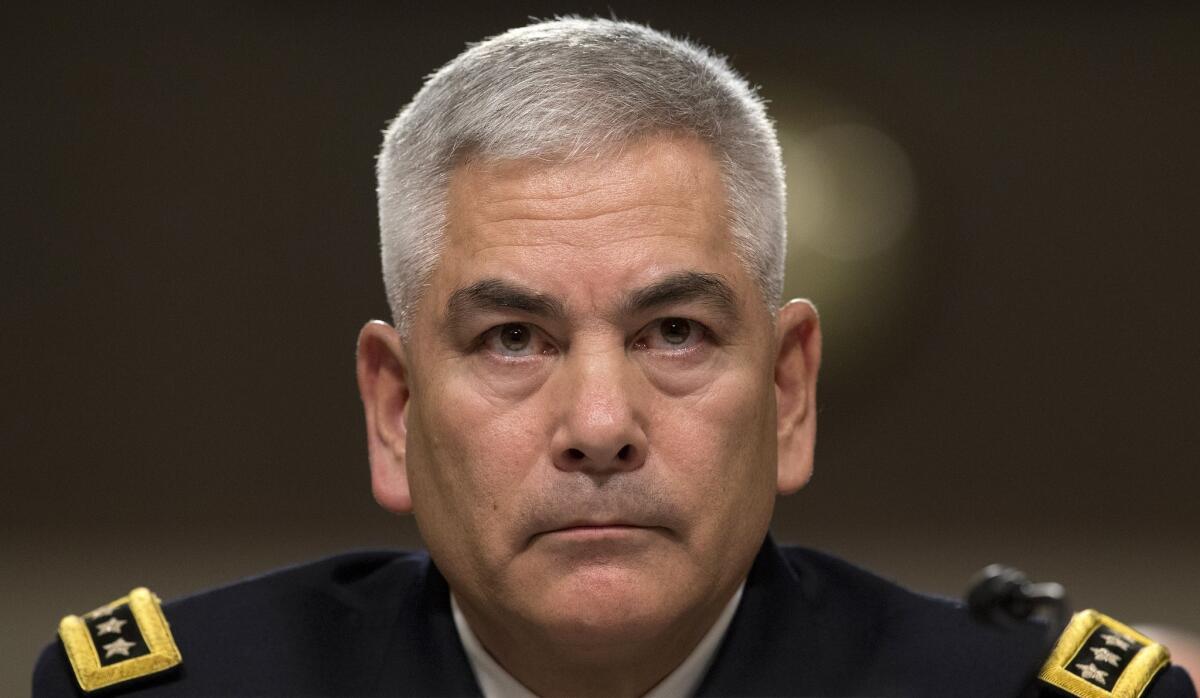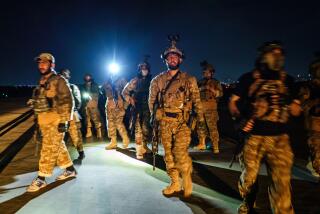Outgoing U.S. commander in Afghanistan warns of worsening security

Gen. John Campbell, the top American commander in Afghanistan, testified before Congress that he believes worsening security conditions demand a greater number of U.S. forces.
- Share via
Reporting from Washington — The outgoing commander of U.S. and NATO forces in Afghanistan warned Congress on Tuesday that security there will deteriorate further from a resurgent Taliban unless the U.S. military makes a long-term commitment to stay.
Army Gen. John F. Campbell, who has led the international force since August 2014, said the Afghan military is “uneven and inconsistent” on the battlefield and is beset by corruption. He said the central government in Kabul probably won’t be able to fully defend itself until the 2020s.
The warning is the latest from a U.S. military officer that suggests the Pentagon wants to reconsider President Obama’s plan to cut the current U.S. deployment of 9,800 military advisors and Special Operations troops in half by the time he leaves office.
It comes after a year that saw Afghan army and police suffer thousands of casualties as U.S.-led coalition troops steadily withdrew from the battlefield as part of Obama’s effort to end America’s longest war.
Campbell indicated to the House Armed Services Committee that he favors keeping the full complement of U.S. troops in Afghanistan at least through this year to bolster the fragile Afghan government.
“Afghanistan is at an inflection point,” Campbell said. “I believe if we do not make deliberate, measured adjustments, 2016 is at risk of being no better, and possibly worse, than 2015.”
Last week, Army Lt. Gen. John W. Nicholson Jr., who has been nominated to replace Campbell, gave a similar message to the Senate committee. He promised to prepare a detailed assessment within 90 days of taking the job to determine how many U.S. troops are needed.
Most U.S. troops are focused on advising Afghan police or military troops, or are tracking and killing fighters from Al Qaeda and, in recent weeks, Islamic State. Both extremist groups sought to establish sanctuaries in Afghanistan in 2015, he said.
Battles with the Taliban last year also revealed glaring weaknesses in Afghan security forces.
In September, Taliban fighters overran the northern town of Kunduz, the first urban area they had captured since the U.S.-led invasion in 2001 after the Sept. 11 attacks.
On Oct. 3, a U.S. AC-130 gunship attacked a hospital in Kunduz run by Doctors Without Borders, an international aid group, killing more than 40 people in the worst such incident of the war. The Pentagon called the airstrike a mistake.
Security remains in flux, Campbell told the committee.
At any given time, about one-fourth of the 407 district centers are “at risk” of falling to militant groups, including Islamic State, he said.
A report released Jan. 30 by the Pentagon’s independent inspector general said the Taliban controls more territory now than at any time since the war began.
The White House has authorized more airstrikes against Islamic State positions, particularly in the eastern province of Nangarhar, where the group has gained strength.
The Sunni Muslim extremist group has attracted 1,000 to 3,000 fighters, U.S. officials say. Many shifted allegiance from other militant groups, including Al Qaeda.
According to local media reports, U.S. airstrikes on Monday killed 29 militants and destroyed a radio station, known as Voice of the Caliphate, that was used to broadcast propaganda for Islamic State.
Last month, a U.S. Army staff sergeant was killed and two fellow Green Berets were wounded in a battle between coalition forces and Taliban near Marjah, in the southern province of Helmand.
Campbell was asked why the Afghan government could not fend for itself after the U.S. and its allies have spent tens of billions of dollars over the last 15 years.
He replied that the Afghan army was essentially a collection of guerrilla fighters and militias at the start of the war.
“Too many times we try to compare the Afghan security forces with the U.S. Army,” Campbell said. “The U.S. Army has been around for 240 years.”
Follow @wjhenn for military and defense info.
More to Read
Sign up for Essential California
The most important California stories and recommendations in your inbox every morning.
You may occasionally receive promotional content from the Los Angeles Times.











